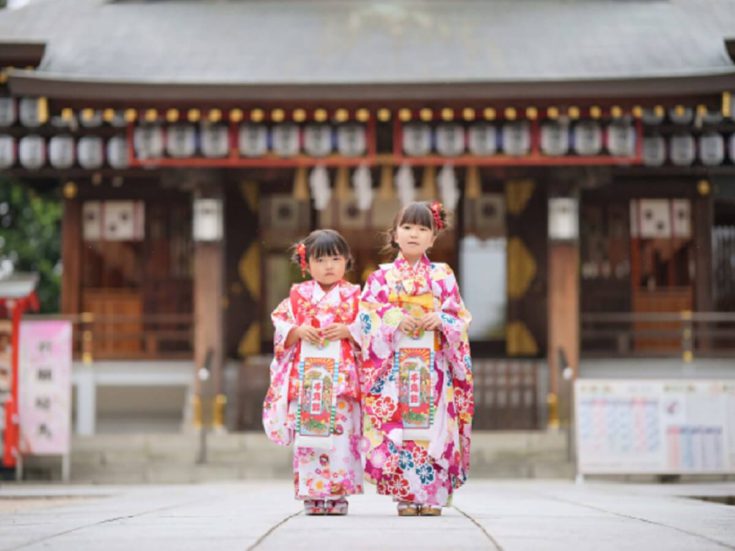Welcome to my new blog post about Japanese lifestyle and traditions in November.
Speaking of November, shichi-go-san”七五三” is a famous event in Japan.
It is the ceremony for 7-year-old girls, 5-year-old boys, and 3-year-old girls and boys. Shichi means “seven,” go means “five,” and san means “three.”
We tend to put our kids in Japanese kimonos and go to a shrine to pray for their healthy growth.
You can watch them at any shrine around the first half of November.
It is said that it will be held mainly on the 15th of November.
We buy long, red and white candy called chitose ame (千歳飴).
Chitose means “a thousand years,” so it relates to long lives and good health. Ame means “candy.” In addition, I suppose this kind of candy is a lot, so it might be difficult for children to eat all of it.


Now, I will introduce some national holidays and events in November.
National holiday Ⅰ: Cultural day “文化の日”
Cultural Day started on November 3, 1948, and its purpose is to promote a culture of love and peace.
On the same day, the Order of Culture is given by the Japanese Emperor.
There are several people honored for their activities, novels, traditional culture, Nobel prize winners, and so on.
Several museums also offer free entrance on this day, so please check out museum offerings, if you want to go.
For example: The National Museum of Western Art

Event Ⅰ: Daimyo’s procession “大名行列”
I sometimes visit Hakone, which is a famous sightseeing area in Japan
There is a mountain, lake, forest, hot springs museum, etc.
On the 3rd of November, the Hakone sightseeing association held the Hakone Daimyo Gyoretsu, the annual parade with a feudal lord’s procession, geisha, and more.

What is the original Daimyo-Gyoretsu?
It is like an imitation of Sankin Kotai, which was the duty of lord to the general for almost two hundred years in the Edo Era (1608-1868).
The lords “Daimyo” ruled the territory of their own were vassals of general “Syogun.”
They were ordered to come to Edo (Tokyo) each year or a half year.
When they came to Edo, they had to stay a year in Edo.
During their time living in Edo, they needed to come with many people.
So, once they went to Edo, there was a long procession called “Gyoretsu,” that is Daimyo-Gyoretsu.
It was the longest way from the Kyushu area, which is located in the south part of Japan.
It took one thousand seven hundred kilometers from their territory—almost two months.
National holiday Ⅱ: Labor Thanksgiving Day “勤労感謝の日”
It is the last national holiday within a year.
It originated from the imperial harvest festival, which is called “Niiname-sai.” Thanks to the harvest, five grains, the Emperor prays for harvests and people at the shrine and eat grains.
Mostly, people think about thanks for labor and harvest and express thankfulness for each other.
On the same day, the Japanese Electrical Manufacturers Association (JEMA) decided to celebrate Rice Cooker Day in 2016.
Some shops or producers may start campaigns for a new rice cooker.

Event Ⅱ: Tori no Ichi “酉の市”
It is an event which is held at shrines that are related to eagles and birds, like “酉” (tori).
It is said that the shrine’s god (o tori sama) rides on the back of an eagle.
“酉”’s day is arranged by the twelve zodiac signs in Chinese astrology.
In this month’s case, the 11th and 23th are the days of ”酉.”
This event originated from Yamto Takeru, the most well-known person in old stories written about one thousand and three years ago. He was treated as a traditional hero, especially in battle.
It is said that he prayed to win the battle at the shrine, and he put his weapon called Kumade (熊手) in front of a pine tree near the shrine.
Kumade turns into a lucky charm at Tori no Ichi.
For Example: Otorisama and Asakusa Tokyo.

What are the benefits of Kumades?
A kumade is just a cleaning tool, known in English as a “rake,” for gathering leaves and so on.

However, kumades is decorated with some stuff in the Tori no ichi.
There are some opinions:
- Kumade has a hook that resembles an eagle’s nails, which leads to grabbing good luck and fortune.
- Samurai Yamato Takeru, too, brought a weapon or tool to the shrine, and he won a battle, which in turn brought good luck and victory.
- Others believe these rakes will help gather prosperity and success.
Event Ⅲ: Beaujolais Nouveau
On the third Thursday in November, many shops in Japan display “Beaujolais Nouveau is released!”
This event originates from the French as farmers are thankful for the harvest, making wine with new grapes and drinking them.
Nowadays, it is common in Japan, too.
Because of the international date line, we can drink Beaujolais Nouveau in Japan earlier than in France, about eight hours.
It is said that this celebration was imported to Japan in 1976, and gradually, it became famous.
Some old news program showed people drinking it at the airport, which meant that people in Japan were drinking even before people in France were… So, every year, people in Japan can celebrate Beaujolais Nouveau even earlier than those in France!
I’m not familiar with wine, but I have added this information here, in case you find it helpful.
That is from the Beaujolais area, where farmers harvest grapes, bottle them immediately, and produce them in November.
It is said that this kind of viral situation is only in Japan.
I would like to check if I could visit abroad on the third Thursday of November.

In conclusion, let’s have a look at seasonal events in Japan and grab some luck. I would like to share with you some events next time, too.
I think some of the stories are a bit funny, not traditional, though, like Rice Cooker Day.

I have been learning English for about 3 years. I have joined many kinds of English schools or social networking to get knowledge and skills for English since then.
My target for learning English is not so clear but my curiosity leads me to make a conversation with everyone in the world with English.
See you somewhere!





 HTJ has a YouTube page! Check it out
HTJ has a YouTube page! Check it out